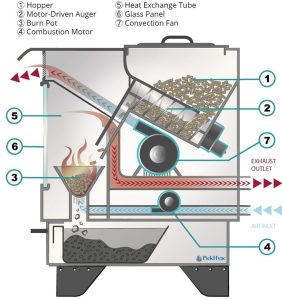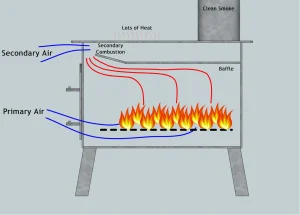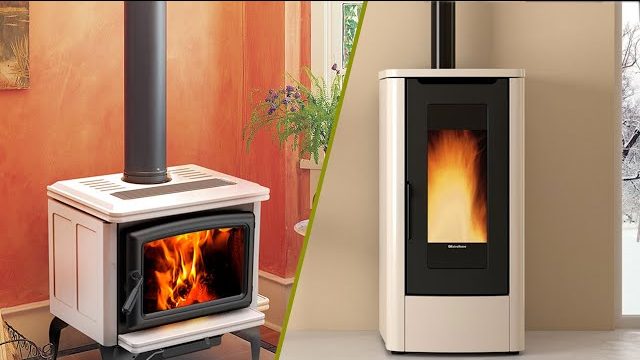- How Do Pellet Stoves Work?
- How Do Wood Burning Stoves Work?
- Pellet Stoves vs Wood Burning Stoves
- 1- Efficiency
- 2- Heating Performance
- 3- Environmental Impact
- 4- Fuel Availability
- 5- Fuel Storage
- 6- Maintenance
- 7- Price
- 8- Fuel Cost
- 9- Operation Comfort
- 10- Aesthetics
- 11- Life Span
- 12- Flue vs Chimney
- 14- Safety and Shut Down Speed
- Conclusion
Wood burning has been a way of keeping our homes warm during winter time for thousands of years. In recent decades, we could see wood stoves are being replaced by pellet stoves. On top of this, recent advances in wood waste and wood food stock processing have brought down the price of pellet, so that it is now more comparable to that of wood.
Now, wood pellets can be burned in pellet stoves only. These stoves are not cheap, but they’re very versatile and can provide enough heat for any size of a living or business space. With this in mind, the logical question of which one you should choose emerges.
Read Also: Best Pellets For Pellet Stoves A Comprehensive Guide
How Do Pellet Stoves Work?

Pellet stoves work by burning pellets to provide heat for your home. As pellets are very small, with a diameter usually lower than 10 millimeters, these stoves refill the combustion chamber on their own. So, a basic model of a pellet stove has a storage chamber, an auger to deliver pellets to the combustion chamber, and the combustion chamber itself. all these parts work simultaneously to provide a comfortable experience of heating your home.
How Do Wood Burning Stoves Work?

On the other hand, wood-burning stoves work by simply burning the wood logs that you put in. You’ll have to start the fire every morning and for this, you need special fire starters. Some people dislike this, so they use twigs or branches or old leaves as fire starters oftentimes contain toxic chemicals and petroleum. Throughout the day you’ll have to keep the fire going, by opening the stove itself and inserting more wood logs. This should be done every one to two hours, depending on the weather conditions and the desired temperature in the house.
Pellet Stoves vs Wood Burning Stoves
With this in mind we can see that these are two very different ways of burning biomass. This makes them very easy to compare. When comparing wood burning stoves to pellet stoves we should pay attention to the efficiency, the heating performance, the environmental impact, and some specifications of fuel. On top of this, the price of the stoves themselves should be considered and some more factors.
1- Efficiency
Burning of any kind can never be 100% efficient. This being said, pellet stoves are around 90% efficient, with some more expensive models getting close to 95% of combustion efficiency. This means that around 90% of heat that is stored in each kilogram of pellet will be sent into your space and will be used to heat your home. When it comes to woodstoves, their efficiency is closer to 80 percent. As they burn firewood of uneven sizes and coming from different types of trees, increasing their efficiency is very difficult.
2- Heating Performance
When it comes to the heating performance, it is useful to note that, thanks to the automated operation, wood pellet stoves or simply pellet stoves are going to provide you with a more consistent power output. This will result in a consistent temperature throughout your living space.
With larger models you will also be able to heat your entire home and even divide it into several zones. Thanks to the mechanisms and the electronics in them, pellet stoves can also be programmed, so that they turn on at specific periods of the day and turn off when you don’t need them to heat your space, for example, when you’re away at work or when you’re sleeping. This simply cannot be done with wood burning stoves, as all the operation is completely manual.
3- Environmental Impact
When it comes to the environmental impact, there are several factors to consider. First of all, if you consider cutting down the forests and the trees, they are cut in the production of both types of fuel. With this being said, the environmental impact of the two should be seen as the difference in their efficiency and as a factor of how sustainably the trees are felled. For every 5 kWh of energy that wood pellets store, you can use 4.5. For every 5 kWh of energy that wood logs store, you can only use 4 to heat your home.
Bear in mind that the latter efficiency is specific to more expensive models only. Cheaper and older models of wood stoves are going to be less efficient. When it comes to the pollution that is released through the flue or the chimney, it is useful to note that wood pellet stoves release less smoke and PM particles than wood stoves. However they also consume some electricity, around 100 Watts, so this electricity usage should also be included in your understanding of the environmental impact of heating your home.
4- Fuel Availability
Both wood logs and wood fuel pellets are readily available. When seeking to purchase them, there are still some differences. Wood logs have to be ordered from special services, and you oftentimes have to wait for days or weeks for them to be delivered to your home address. When it comes to wood pellets, this is only true if you want to buy them in bulk. Many home goods stores and even supermarkets sell them readily available and pre-packed in 15-18 kilo bags.
5- Fuel Storage
When it comes to storing the two, wood pellets definitely win. Wood pellets come in small bags that are easy to stack one on top of another. If you want to purchase them by a ton, they will be delivered on pallets that can, again, be stored one on top of another. This helps you save a lot of space. In addition to this pellets also take up less volume per unit of energy stored. So 1 cubic meter of pellets stores the same amount of energy as around two to three cubic meters or wood logs.
6- Maintenance
When it comes to the maintenance of these two types of stoves, there is a stark difference between the two. While wood stoves need to be cleaned every day, and the ashes be taken out on a daily basis, the pellet solves only need to be cleaned once a week. However, wood pellet stoves need regular yearly inspection and replacement of any parts that have worn out. This can increase the maintenance costs. Wood fuel stoves do not need these inspections.
7- Price
When it comes to the price, depending on the country and the region of the world you live in, you can expect to pay upwards of $1000 for a wood stove or upwards of $2000 for a wood pellet stove. On top of this, you need to check with your local services and see what the installation costs are. If your home does not have a flu or a chimney, you will have to count in the installation costs for these as well. On top of this, wood stoves need a regular yearly cleaning of the chimney, while wood pellet stoves need yearly check-up and cleaning done by professionals.
8- Fuel Cost
In most regions of the world, the fuel costs in both cases are almost the same. Depending on the region you live in, you can see up to 30% of the difference in the price, with the pellet usually being more expensive than wood logs. The recent events between Russia and Ukraine have increased the prices of wood pellets throughout the world.
9- Operation Comfort
The operation comfort is probably the easiest factor that we discuss today. When starting a fire in a wood stove, you need a fire starter and some good 1-5 minutes to start the fire. On top of this, you will need to wait anywhere between half an hour and one hour until your living space has reached the desired temperature. In comparison, with wood pellet stoves, you only need to press a button, and with some models this button can be on your phone. With Wi-Fi abilities,you can start this pellet stove hours in advance or you can pre-program it to turn on a specific period of the day.
10- Aesthetics
When it comes to the aesthetics as the difference factor between these two types of stoves, you need to consider what you like the best. If you prefer the aesthetics of a wood log on fire, then a wood burning stove should be your choice. Wood pellet stoves can also be very beautiful, and these stoves can be installed in your basement or even outside of your home, for as long as you have a sheltered area to put them in. This way your space remains unobstructed.
11- Life Span
When it comes to the lifespan of these two types of stoves, it is useful to note that wood stoves have very few moving parts and zero electronics in them that could break down. They work even when there is no electricity and they can last you for decades to come. When it comes to pellet stoves, they’re very comfortable and easy to use, but they do have electronics that can break down if lightning strikes nearby or simply due to the normal wear and tear due to their use.
12- Flue vs Chimney
In both cases you will need to have a flu or a chimney to burn any kind of biomass to provide heat for your home. When speaking about flues, they can be fast and relatively cheap to install. However wood stoves demand a good quality chimney to be able to operate with no condensation and no condensate matter running down your walls. In both cases if you have neither a flue or a chimney, you will need to pay for the installation
14- Safety and Shut Down Speed
When it comes to the safety and the shutdown speed of these two types of stoves, they are as different as it gets. Pellet stoves take mere minutes to shut down, so you will be leaving your home on a short notice with a piece of mind that there are no flames running in your home. On the other hand, depending on how many fire logs you have fed into your wood stove, the flames could keep on going for hours to come. Although accidents are very rare, they still do happen.
Conclusion
All in all, wood stoves and pellet stoves represent very different technologies for providing heat for your home. Although they both rely on combustion, a variety of factors should be taken into consideration when deciding on which one to purchase for your next property. In any case, you will not make a mistake whatever you choose, as the final choice relies on you and your personal needs.


